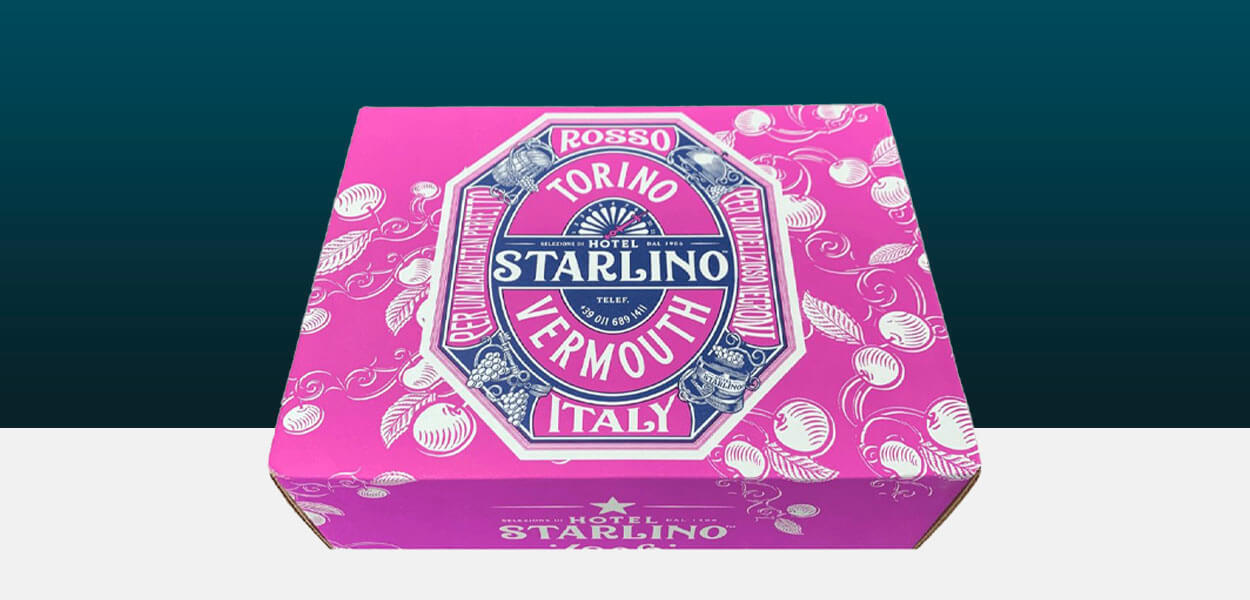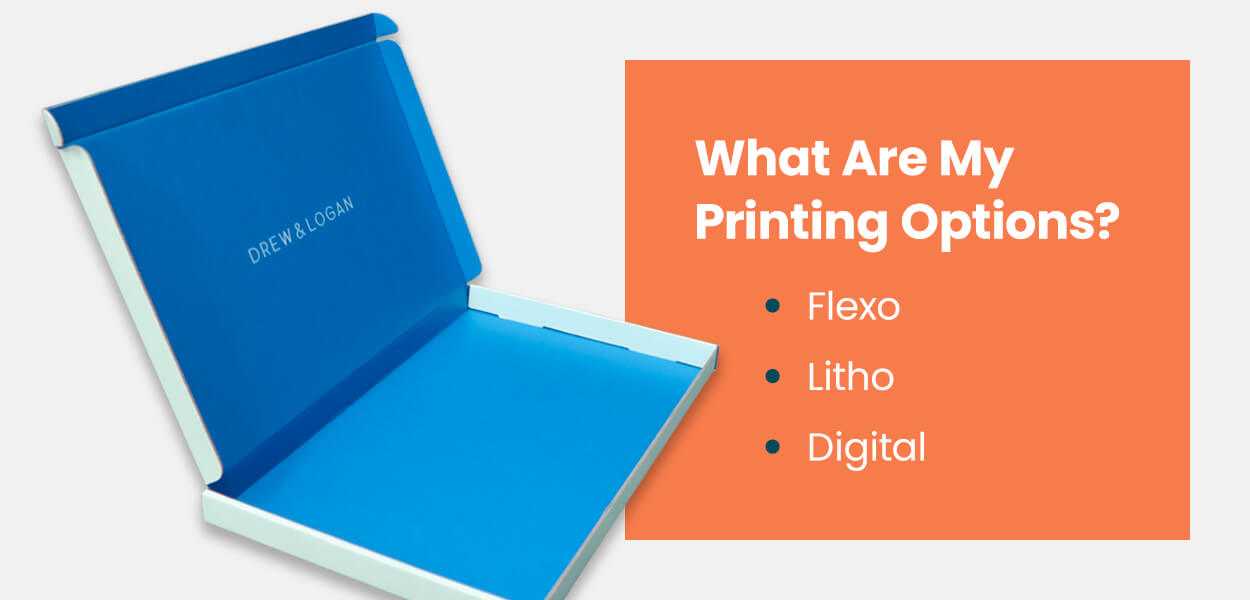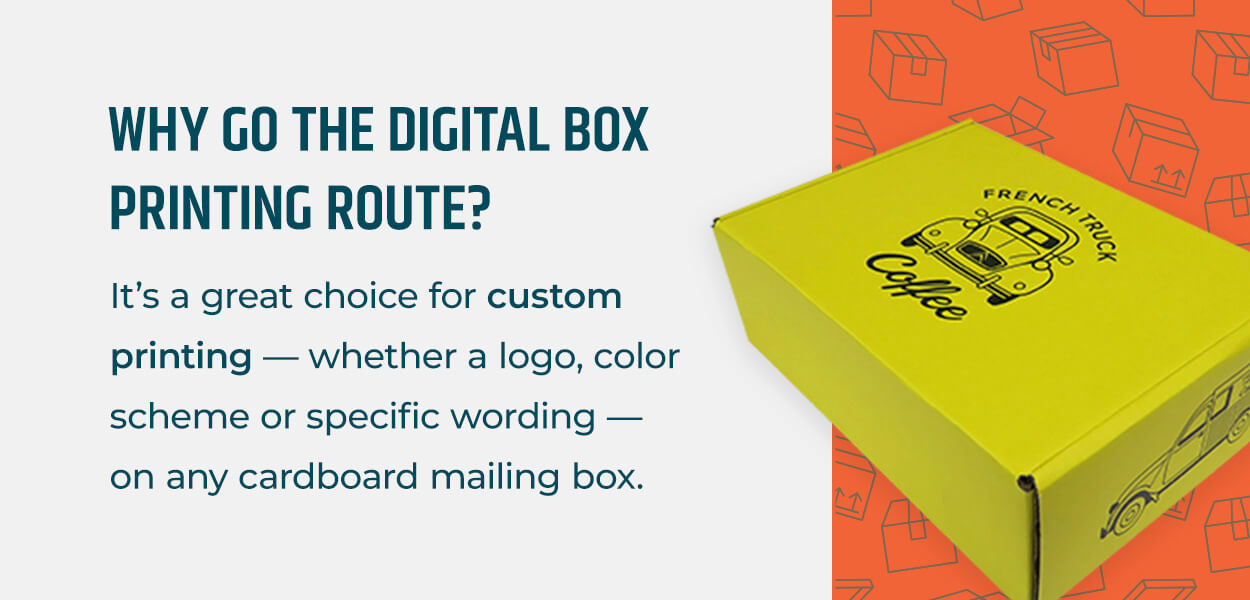
You know you need to custom print your boxes. That much is a given. But what type of printing should you use? How do you know if it’s the right option? How does lithographic box printing differ from flexographic or digital, anyway? Does it even matter?
Picking the right packaging printing method is more significant than you might think — your packaging design choices can have a huge impact on your sales.
If you feel overwhelmed when you’re at the design stage of your packaging, we’re here to help. Our printing options can help you create the best possible packaging design.

You have a lot of things to consider when packaging a product. One of the first choices you make should be the way you want your design printed. You have a few basic print options, including:
According to industry research, packaging and design matter quite a bit to consumers. A recent Paper and Packaging Board and IPSOS study found over 70% of consumers agree that packaging design influences their buying decisions. Packaging is important — there’s a lot riding on it. Everything from the box type, your logo placement, and the type of printing process you use affects the finished product. If you understand your options before you order your custom printed packaging, you can make strategic decisions about your printing and packaging options.
One of the more traditional printing methods is flexography. Flexo printing is a direct-to-surface method using relief plates and anilox rolls. In flexo printing, a raised image is pressed onto a flexible relief surface, similar to the letterpress “stamping” in the early era of newspapers. You can create the raised-image plate in three different ways:
Once the raised image is complete, you insert the plates into a press. Tiny cups hold exact amounts of ink, which they deposit onto the printing surface. In the past, you’d have to wait for the ink to dry to avoid smudging, but today, technology allows for quick drying. This is useful for large-scale reproductions. For cardboard and paper printing, it’s best to opt for water-based ink.
Should you pick flexo printing? Whether or not to choose flexo printing depends on your goals and your priorities. One key benefit to flexography is its economic prices. It’s also versatile, allowing you to print on a wide variety of surfaces. In addition, flexo is a good option if you want to print the same image many times, maintaining consistency with each. It’s ideal for printing large-scale continuous patterns, too, such as for wallpaper or gift wrap.
One thing to keep in mind is that flexo printing is not well-suited to high-resolution images. If your design includes intricate patterns or photographs, you’ll want to opt for lithographic or digital printing. However, if you have a simpler design for your product boxes, flexographic printing is a sound choice.
Flexography is a popular print application method thanks to its versatility and consistency. Given flexo printing’s benefits, it may be the right choice for you. Here are some scenarios in which flexo printing could be the best option:
Simplified forms of lithographic printing were around during ancient Greek times. In Greek, “litho” means stone and “graphein” means to write. Ancient people would carve stones to create stencils. The technology has advanced quite a bit since then. Today, litho printing takes advantage of oil and water’s aversion to each other. It involves etching a design onto an aluminum plate, using a laser, mechanical or photochemical process.
Once the design is complete, water and ink roll over the printing plate. The water wets the non-image areas while the ink adheres only to the image areas. This results in clean, accurate copies every time. The ink is transferred to a rubber blanket and rolled over the print surface. Because the ink passes from the plate to a blanket to the final print surface, it’s earned the nickname “offset printing.” The image is “offset,” not applied like a stamp. It takes multiple layers of various ink colors to create the final product. The process takes careful setup and planning.
Litho printing results in high-resolution, clear, smooth images. It’s great for bulk print orders and one of the most economic options for high-quantity demands. It’s also ideal for more intricate designs, as it can accommodate up to six different colors. It can also conform to a wider range of materials because its rubber blanket is flexible, unlike the metal plates used in most direct-to-surface methods. If you’re looking for a print solution that will result in high-end, magazine-quality results and that is ideal for vibrant colors and large quantities, litho printing is right for you.
Another benefit to lithographic printing is its lack of impressions. This comes down to personal preference — some companies like the feel of impressions from ink printing. Others find it distracts from their brand message. Impressions can also make printed items thicker, which can affect transportation and storage. If you want a smooth, impression-free printing option, litho is a good choice. Digital also provides impression-free printing.
Litho printing has been around for a long time and is a tried-and-true printing method. It has many advantages and could be the best choice for you. Here are some of the reasons to choose litho printing:
Digital printing is the process of printing electronic images onto a variety of substrates. It’s a direct-to-surface printing method, unlike offset printing. While there are several traditional printing methods, including lithography, flexography and others, digital printing is often preferred for branded boxes.
Why the popularity? Digital box printing eliminates the need for many of the steps associated with conventional printing, such as making color proofs and films and creating plates. Also, digital printing requires no extra formatting equipment like photo chemicals or film plates. The pre-press stages between the digital document files and the final product are unnecessary. The stages of digital printing are as follows:
This simple, electronic process makes it much easier to vary or customize prints, allowing for subtle differences without having to create new physical plates or rolls. The process is quicker and simpler than other, traditional methods.
Of all the printing options, digital printing is currently the fastest-expanding market segment, growing 13% every year. It’s a great choice for custom printing — whether a logo, color scheme or specific wording — on any cardboard mailing box.

One of the most obvious differences between digital and all other print options is that digital printing doesn’t require tooling or die. Digital print is print applied directly to corrugated material, no cutting dies or print plates needed. It’s ideal for smaller orders of about 1-500 boxes per order. Other reasons to opt for digital printing over alternatives like litho and flexo are:
An increasing number of companies are choosing digital printing methods over alternatives. Digital printing may be the right option for you for a number of reasons. Here are some of the instances in which digital might be the best choice:
Beyond choosing the best printing method for your custom boxes, you also need to decide on a material that helps you show off your products in a catchy way. The best material for packaging offers flexibility and versatility to bring out the desired colors and artwork as you envisioned them. There are two common packaging materials for printing worth looking into:
Corrugated boxes make excellent canvasses for superior digital, lithography and flexo printing. There are two types of corrugated box materials that deliver different printing results:
Kraft boxes have a typical matte cardboard feel and brown color that’s perfect for printing minimal designs in darker colors. Packaging designs on kraft corrugated boxes are best for brands going for a rustic and eco-friendly image because they’re 100% recyclable and biodegradable. They work best with dull and dark colors such as black, navy blue and jungle green because lighter colors are altered by the natural brown color on the boxes to appear earthy and flat.
You can add vibrancy and contrast to your designs by printing your logo and artwork on a layer of digital white ink. While they can handle most styles, designs and shapes of company logos, mascots and messaging, they’re not the best option for multi-color prints and complex artwork and designs.
Brown kraft corrugated boxes work well for natural beauty and skincare product brands, sustainable clothing brands, and many other brands that want to appear reliable, green and trustworthy to their clients.
White corrugated boxes provide a clearer and easier canvas to print on any colors and complex artwork and designs. They offer more design flexibility when you’re looking to create vibrant and unique designs. Additionally, they work better with bright, saturated and neutral colors than kraft corrugated boxes, keeping them true to their natural hues and lending them the perfect vibrancy and contrast.
Standard white corrugated cardboard boxes create a dreamy unboxing experience for customers that they won’t resist sharing on their social media pages. Unfortunately, white corrugated boxes contain very small amounts of recycled materials and are not the most sustainable or eco-friendly packaging option. But they give your packaging an elegant and sophisticated feel, providing customers with additional perceived value.
Because even the inside of these boxes is white, they are the best choice for the food, medical and health industries where clients need to be assured of the cleanliness and safety of their products. Using them for packaging products in these industries may drive up your credibility and customer’s trust and loyalty to your brand.
The look and feel of packaging make a big difference to consumers. High-quality box printing and manufacturing can make your products more appealing and help you generate more sales. Whether you need digital box printing or any other printing for your product packaging, Bolt Boxes is here to help. We offer several printing capabilities, including digital, litho and flexo printing to best meet your unique specifications. We are printing experts, with a G7 Master Qualification that lets us bring our expertise into your brand efforts.
For almost 60 years, we’ve been committed to providing our customers with custom printing options for any box type. We offer C-series mailing boxes, RSC standard shipping boxes and end-loading corrugated boxes for all your shipping and mailing needs. With our online configurator, you can easily add logos and other branded images to your digital printed cardboard boxes. To learn how you can elevate your brand with custom packaging services, contact us today. Or get started creating your custom box!